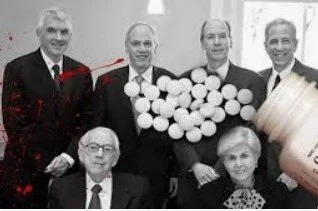ADDICTION…
WHEN YOU PUT A QUARTER IN A GUMBALL MACHINE, TURN THE HANDLE, LIFT OPEN THE METAL DOOR, A GUMBALL ROLLS OUT INTO YOUR PALM. THIS MAKES YOU HAPPY.
IF YOU PUT ANOTHER QUARTER IN THE MACHINE AND WHEN YOU LIFT THE DOOR YOU GET TWO GUMBALLS, THAT’S BETTER THAN YOU EXPECTED.
Imagine the next 30 quarters you put in the gumball machine results in 2 gumballs. On the 31rst quarter you only receive one. The one gumball doesn’t bring happiness anymore. And now the two gumballs aren’t better than expected, you actually want three.
The happiness originally felt by receiving one gumball was triggered in the ancient reptilian part of our brain. When early man ate food or found a mate the brain would release a “feel good” nudge to encourage man to do that again. This was essential to survival because this created priorities and urgency. Without a system to determine the importance in activities the brain can’t make decisions and extinction would be likely.
The two gumballs represent the dopamine factor in the brain. Dopamine assigns the level of importance to our existence by the dopamine response. Opioids flood the brain times a million and our brain wasn’t meant for that much pleasure, especially continued use. Over time the two gumballs give you less and less dopamine and you focus more on getting three. The one gumball triggers no pleasure at all now.
People in active addiction are in a constant cycle of seeking more opioids. Everything that used to make them happy like friends, family, work, relationships, (the one gumball) doesn’t trigger that “feel good” chemical in their brain. This rearranged the priorities that were originally established from childhood. Making the drug the most important thing in their life.
I’ve been hurt by my son over and over in this journey and it wasn’t until this was explained to me that I was able to understand his actions. Right now, I’m not important to him. I am just the person he can use to steal from and take advantage of to achieve his instinct for survival. Because he’s not my son. This is the addict trying to not become extinct.
Without an avenue for intervention, I don’t believe it’s possible to get him to treatment. His brain is rewired, his addiction is involuntary and his actions are automatic. This isn’t about morals and will-power anymore, this is a brain disease.
PERSISTANT DRUG USE DESPITE NEGATIVE CONSEQUENSES
RESISTANT TO TREATMENT
Perhaps the more perplexing—and frustrating—aspect of opioid addiction is the dramatic shift seen in individuals’ behavior. From the outside, it appears as if individuals’ basic survival instincts may be subsumed by their addiction: they start to behave as if the drug is the most important thing in the world and they will literally risk their lives to obtain it.
This phenomenon is captured through the concept of incentive salience—essentially, how the brain attributes value and importance to objects in the environment. As opioid use progresses, neuro-plastic changes in cognitive and reward circuits lead individuals to preferentially attend to opioid- and pain related cues, thereby hindering healthy interactions with the environment .
Neurobiologically, the drug is perceived as holding greater value than naturally occurring rewards (such as food, sex, and socialization.)
CYCLE OF ADDICTION
Stage 1: Intoxication.
The individual experiences pleasant effects of the substance due to the release of dopamine in the brain. Over time, the brain makes a connection between pleasure and the substance, leading the individual to continue using the substance.
Stage 2: Withdrawal.
Once the brain adaptations to the substance have occurred, the individual experiences unpleasant withdrawal effects when the substance wears off. This causes the person to return to the substance, no longer to experience the euphoria or pleasant effects, but to avoid feeling sick from the withdrawal symptoms.
Stage 3: Anticipation.
The individual becomes preoccupied with seeking out the substance after its effects have worn off. The brain’s executive functions, such as emotion control, decision-making, impulse control, and prioritizing tasks, are overridden due to a disruption in brain chemistry. The person loses control over the substance and the addiction cycle repeats.
MEET THE SACKLERS.
“The abuse and diversion of prescription opioids has contributed to a national tragedy of addiction and deaths, in addition to those caused by illicit street opioids,” said Deputy Attorney General Jeffrey A. Rosen. “With criminal guilty pleas, a federal settlement of more than $8 billion, and the dissolution of a company and repurposing its assets entirely for the public’s benefit, the resolution in today’s announcement re-affirms that the Department of Justice will not relent in its multi-pronged efforts to combat the opioids crisis.”
Who is Responsible?
The FDA approved OxyContin in 1995 in spite of the fact that Purdue had conducted no clinical studies on how addictive or prone to abuse the drug might be. But Dr. Curtis Wright, the FDA examiner who approved the drug package insert for OxyContin which announced that the drug was safer than rival painkillers, because the patented delayed-absorption mechanism “is believed to reduce the abuse liability.” Wright left the agency shortly afterward. He later went to work at Purdue.
The Sackler Family and Purdue Pharma
Dr. Curtis Wright
Today, the Committee on Oversight and Reform will hold its second hearing to examine how the Sackler family caused Americas opioid epidemic, one of the deadliest public health crises in our Nation & history. We will hear how they researched it, how they planned it, how they manufactured it, how they sold it, how they marketed it, and, ultimately, how they profited billions from the sale of OxyContin. And we will hear also of the pain and suffering of the people who became addicted to it.
SACKLER FAMILY N PURDUE PHARMA






